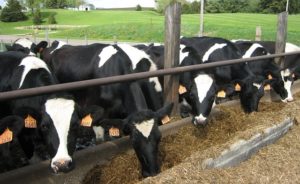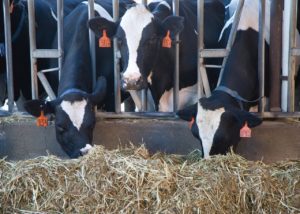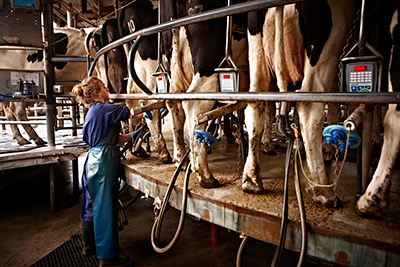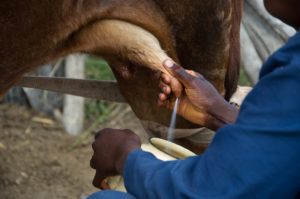 Dairy Cattle
Dairy Cattle
Watch this video to learn about the milking process and innovative technologies used on some dairy farms today! Read the article to learn more about dairy cattle, including hot topics like hormones, antibiotics and safety regulations.
Think about this: Healthy cows are happy cows are productive cows. Farmers ensure their animals are well cared for – their livelihood depends on it. Healthy cows produce high quality milk that can be sold.
No Antibiotic Residue.
Dairy Farmers of Canada (2017)1 states:
“Caring for our cows means treating them when they’re sick.
This includes antibiotic treatments, which are administered according to the advice or under prescription by veterinarians and duly recorded in permanent farm records.
Protecting the Milk Supply – Treated cows  are visually identified so they are milked separately, and that milk is discarded for a mandated time period. The cow’s milk will be accepted again only after antibiotics have cleared the cow’s system, so her milk clears tests for antibiotic residues.
are visually identified so they are milked separately, and that milk is discarded for a mandated time period. The cow’s milk will be accepted again only after antibiotics have cleared the cow’s system, so her milk clears tests for antibiotic residues.
Food safety means integrity – Which is why all milk produced on Canadian farms is tested for antibiotic residues at its arrival at the processing plant.
Any milk that tests suspect positive is discarded – never processed into products that are sold to the public. The farmers responsible are fined heavily.”
No Hormones Allowed.
Dairy Farmers of C anada (2017) 1 states:
anada (2017) 1 states:
“The pure and simple truth: Artificial growth hormones (rbST) used to stimulate milk production are not approved for sale, or permitted for use in Canada.
Canadian dairy farmers respect Canadian standards.
This means that no Canadian dairy cow can be given artificial growth hormones. So, you can feel good knowing your milk, yogurt, cheese and any dairy product made with Canadian milk should not contain any of these artificial hormones.”
Fresh Milk.
“Always on schedule and always fresh – 99.9% of all Canadian milk is picked up from the farm every second day. Plus, all milk truck drivers are trained experts in grading milk by sight and smell. They also inspect, measure, and take sanitary samples of milk before loading it onto the truck.1”
milk is picked up from the farm every second day. Plus, all milk truck drivers are trained experts in grading milk by sight and smell. They also inspect, measure, and take sanitary samples of milk before loading it onto the truck.1”
Feed.
Dairy cattle are fed high quality, nutritious hay, grain or special mixed feed rations to ensure every cow is healthy, strong and receiving the nutrients needed to produce high quality milk.
“Cows have also gotten better at converting feed to milk. The modern dairy cow needs less feed to produce milk… the dairy industry has reduced its carbon footprint by 63% in 65 years.2”.
Robotics!
Traditional methods of milking  are by hand two times a day. Best practices around the world have seen milking practices move to automatic milking machines and more recently robotics (the video at the top of this page is from a dairy operation in Nova Scotia, Canada that uses robotics).
are by hand two times a day. Best practices around the world have seen milking practices move to automatic milking machines and more recently robotics (the video at the top of this page is from a dairy operation in Nova Scotia, Canada that uses robotics).
Keeping the cows clean, calm and relaxed is an important part of their health. If you watch the herd, the cows know when it’s time to get milked. They line up on their own to enter the milking system.
Dairy Products:
There are thousands of dairy products produced from cow’s milk – some favorites are milk, cheese and ice cream!
Here is one example of what 1 cow could potentially produce: 128 glasses of milk per day2.
Assumption: On a daily basis, most cows average about 70 lbs. of milk per day, or about 8 gallons per day. 8 gallons is about 128 glasses of milk per day2.
of milk per day, or about 8 gallons per day. 8 gallons is about 128 glasses of milk per day2.
Learn More
Ask a USA Dairy Farmer a Question:
http://www.dairymoos.com/contact-me/
Fun facts: http://www.dairymoos.com/interesting-facts-about-milk/
See first-hand how cheese travels from the barn to your house:
https://www.youtube.com/watch?v=AARTC-aUzKc
Learn about animal treatment, the milking system, crops, manure management, digester energy and much more from one of the largest operations in the USA:
https://m.youtube.com/watch?feature=youtu.be&v=nxxTKjJn5iM
Sources:
1 Dairy Farmers of Canada (2017): https://www.qualitymilk.ca
2 http://www.dairymoos.com/how-much-milk-do-cows-give/
Images courtesy of: https://pixabay.com/en/photos/?image_type=&cat=&min_width=&min_height=&q=dairy+barn&order=popular, Dairy Australia (2016) http://www.dairy.edu.au/discoverdairy/learning-resources/background-information/s20-how-cows-make-milk


